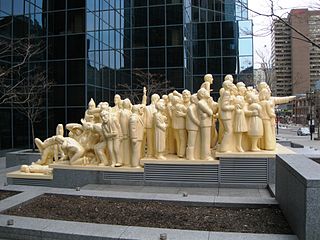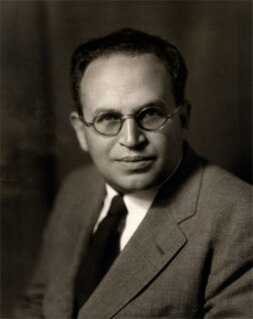Related Research Articles
Advocacy is an activity by an individual or group that aims to influence decisions within political, economic, and social institutions. Advocacy includes activities and publications to influence public policy, laws and budgets by using facts, their relationships, the media, and messaging to educate government officials and the public. Advocacy can include many activities that a person or organization undertakes, including media campaigns, public speaking, commissioning and publishing research. Lobbying is a form of advocacy where a direct approach is made to legislators on a specific issue or specific piece of legislation. Research has started to address how advocacy groups in the United States and Canada are using social media to facilitate civic engagement and collective action.

Robert King Merton was an American sociologist who is considered a founding father of modern sociology, and a major contributor to the subfield of criminology. He served as the 47th President of the American Sociological Association. He spent most of his career teaching at Columbia University, where he attained the rank of University Professor. In 1994 he was awarded the National Medal of Science for his contributions to the field and for having founded the sociology of science.

Communication theory is a proposed description of communication phenomena, the relationships among them, a storyline describing these relationships, and an argument for these three elements. Communication theory provides a way of talking about and analyzing key events, processes, and commitments that together form communication. Theory can be seen as a way to map the world and make it navigable; communication theory gives us tools to answer empirical, conceptual, or practical communication questions.
The hypodermic needle model is a model of communication suggesting that an intended message is directly received and wholly accepted by the receiver. The model was originally rooted in 1930s behaviourism and largely considered obsolete for a long time, but big data analytics-based mass customisation has led to a modern revival of the basic idea.
The knowledge gap hypothesis explains that knowledge, like other forms of wealth, is often differentially distributed throughout a social system. Specifically, the hypothesis predicts that "as the infusion of mass media information into a social system increases, segments of the population with higher socioeconomic status tend to acquire this information at a faster rate than the lower status segments, so that the gap in knowledge between these segments tends to increase rather than decrease". Phillip J. Tichenor, then Associate Professor of Journalism and Mass Communication, George A. Donohue, Professor of Sociology, and Clarice N. Olien, Instructor in Sociology – three University of Minnesota researchers – first proposed the knowledge gap hypothesis in 1970.

The two-step flow of communication model says that most people form their opinions under the influence of opinion leaders, who in turn are influenced by the mass media. In contrast to the one-step flow of the hypodermic needle model or magic bullet theory, which holds that people are directly influenced by mass media, according to the two-step flow model, ideas flow from mass media to opinion leaders, and from them to a wider population. Opinion leaders pass on their own interpretation of information in addition to the actual media content.

In public relations and communication science, publics are groups of individual people, and the public is the totality of such groupings. This is a different concept to the sociological concept of the Öffentlichkeit or public sphere. The concept of a public has also been defined in political science, psychology, marketing, and advertising. In public relations and communication science, it is one of the more ambiguous concepts in the field. Although it has definitions in the theory of the field that have been formulated from the early 20th century onwards, and suffered more recent years from being blurred, as a result of conflation of the idea of a public with the notions of audience, market segment, community, constituency, and stakeholder.

Paul Felix Lazarsfeld was an Austrian-American sociologist. The founder of Columbia University's Bureau of Applied Social Research, he exerted influence over the techniques and the organization of social research. "It is not so much that he was an American sociologist," one colleague said of him after his death, "as it was that he determined what American sociology would be." Lazarsfeld said that his goal was "to produce Paul Lazarsfelds". The two main accomplishments he is associated with can be analyzed within two lenses of analysis: research institutes, methodology, as well as his research content itself. He was a founding figure in 20th-century empirical sociology.
Opinion leadership is leadership by an active media user who interprets the meaning of media messages or content for lower-end media users. Typically opinion leaders are held in high esteem by those who accept their opinions. Opinion leadership comes from the theory of two-step flow of communication propounded by Paul Lazarsfeld and Elihu Katz. Significant developers of the theory have been Robert K. Merton, C. Wright Mills and Bernard Berelson. This theory is one of several models that try to explain the diffusion of innovations, ideas, or commercial products.
The spiral of silence theory is a political science and mass communication theory proposed by the German political scientist Elisabeth Noelle-Neumann. It states that an individual's perception of the distribution of public opinion influences that individual's willingness to express their own political opinions. The main idea is that people influence each other's willingness to express opinions through social interaction. According to the spiral of silence theory, individuals will be more confident and outward with their opinion when they notice that their personal opinion is shared throughout a group. But if the individual notices that their opinion is unpopular with the group they will be more inclined to be reserved and remain silent. The individual "not isolating himself is more important than his own judgement". This is a self-expressive act that can change the "global environment of opinion", shifting the perceptions of others and the willingness of individuals to express their own opinions.

The public sphere is an area in social life where individuals can come together to freely discuss and identify societal problems, and through that discussion influence political action. A "Public" is "of or concerning the people as a whole." Public Sphere is a place common to all, where ideas and information can be exchanged. Such a discussion is called public debate and is defined as the expression of views on matters that are of concern to the public—often, but not always, with opposing or diverging views being expressed by participants in the discussion. Public debate takes place mostly through the mass media, but also at meetings or through social media, academic publications and government policy documents. The term was originally coined by German philosopher Jürgen Habermas who defined the public sphere as "made up of private people gathered together as a public and articulating the needs of society with the state". Communication scholar Gerard A. Hauser defines it as "a discursive space in which individuals and groups associate to discuss matters of mutual interest and, where possible, to reach a common judgment about them". The public sphere can be seen as "a theater in modern societies in which political participation is enacted through the medium of talk" and "a realm of social life in which public opinion can be formed".
Mass communication is the process of imparting and exchanging information through mass media to large segments of the population. It is usually understood for relating to various forms of media, as its technologies are used for the dissemination of information, of which journalism and advertising are part. Mass communication differs from other types of communication, such as interpersonal communication and organizational communication, because it focuses on particular resources transmitting information to numerous receivers. The study of mass communication is chiefly concerned with how the content of mass communication persuades or otherwise affects the behavior, the attitude, opinion, or emotion of the people receiving the information.
In media studies, mass communication, media psychology, communication theory, and sociology, media influence and media effects are topics relating to mass media and media culture's effects on individual or an audience's thoughts, attitudes, and behavior. Whether it is written, televised, or spoken, mass media reaches a large audience. Mass media's role and effect in shaping modern culture are central issues for study of culture.
Audience theory offers explanations of how people encounter media, how they use it, and how it affects them. Although the concept of an audience predates media, most audience theory is concerned with people’s relationship to various forms of media. There is no single theory of audience, but a range of explanatory frameworks. These can be rooted in the social sciences, rhetoric, literary theory, cultural studies, communication studies and network science depending on the phenomena they seek to explain. Audience theories can also be pitched at different levels of analysis ranging from individuals to large masses or networks of people.
Selective exposure is a theory within the practice of psychology, often used in media and communication research, that historically refers to individuals' tendency to favor information which reinforces their pre-existing views while avoiding contradictory information. Selective exposure has also been known and defined as "congeniality bias" or "confirmation bias" in various texts throughout the years.
Herta Herzog-Massing was an Austrian-American social scientist specializing in communication studies. Her most prominent contribution to the field, an article entitled "What Do We Really Know About Daytime Serial Listeners?", is considered a pioneering work of the uses-and-gratifications approach and the cognitive revolution in media research. She was married to Paul Lazarsfeld, and later to Paul Massing, and was stepmother to Lazarsfeld's daughter, MIT professor Lotte Bailyn.
The multi-step flow theory assumes ideas flow from mass media to opinion leaders before being disseminated to a wider population. This theory was first introduced by sociologist Paul Lazarsfeld et al. in 1944 and elaborated by Elihu Katz and Lazarsfeld in 1955.
The Political Economy of Communications, news, or media, is a particular branch in Communication studies or media studies which studies the power relations that shape the communication of information from the mass media to its publics. This concept has been developed by media and political economy scholars such as; Dallas Walker Smythe, Herbert Schiller, Graham Murdock, Peter Golding, Vincent Mosco, Dan Schiller, and Robert W. McChesney. PEC analyzes the power relations between the mass media system, information and communications technologies (ICTs) and the wider socioeconomic structure in which these operate, with a focus on understanding the historical and current state of technological developments.
Media hegemony is a perceived process by which certain values and ways of thought promulgated through the mass media become dominant in society. It is seen in particular as reinforcing the capitalist system. Media hegemony has been presented as influencing the way in which reporters in the media – themselves subject to prevailing values and norms – select news stories and put them across.
Hazel Gaudet-Erskine was an American social and communications scientist and a member of the Princeton Radio Project.
References
- Baran, S.;Davis, D: Mass Communication Theory (fifth edition) (Wadsworth, 2009).
- Lazarsfeld, Paul Felix, and Robert King Merton. Mass Communication, Popular Taste and Organized Social Action. Bobbs-Merrill, College Division, 196AD.
- Mateus, S. (2020). Narcotizing dysfunction. In D. Merskin (Ed.), The SAGE international encyclopedia of mass media and society (Vol. 1, pp. 1159-1161). Thousand Oaks,, CA: SAGE Publications, Inc. doi: 10.4135/9781483375519.n440
